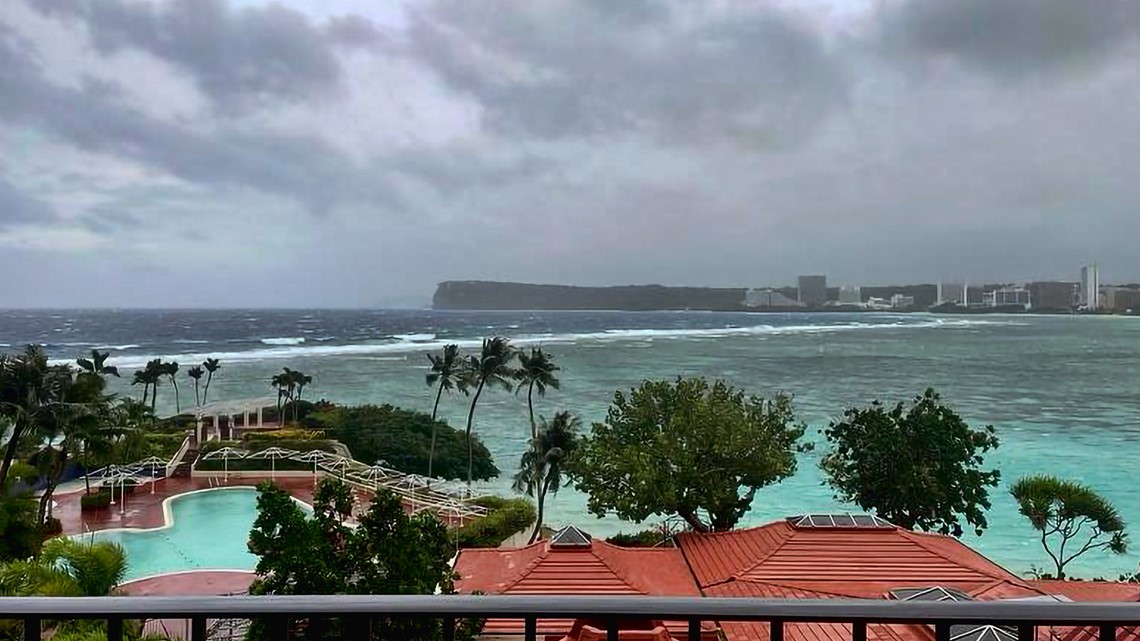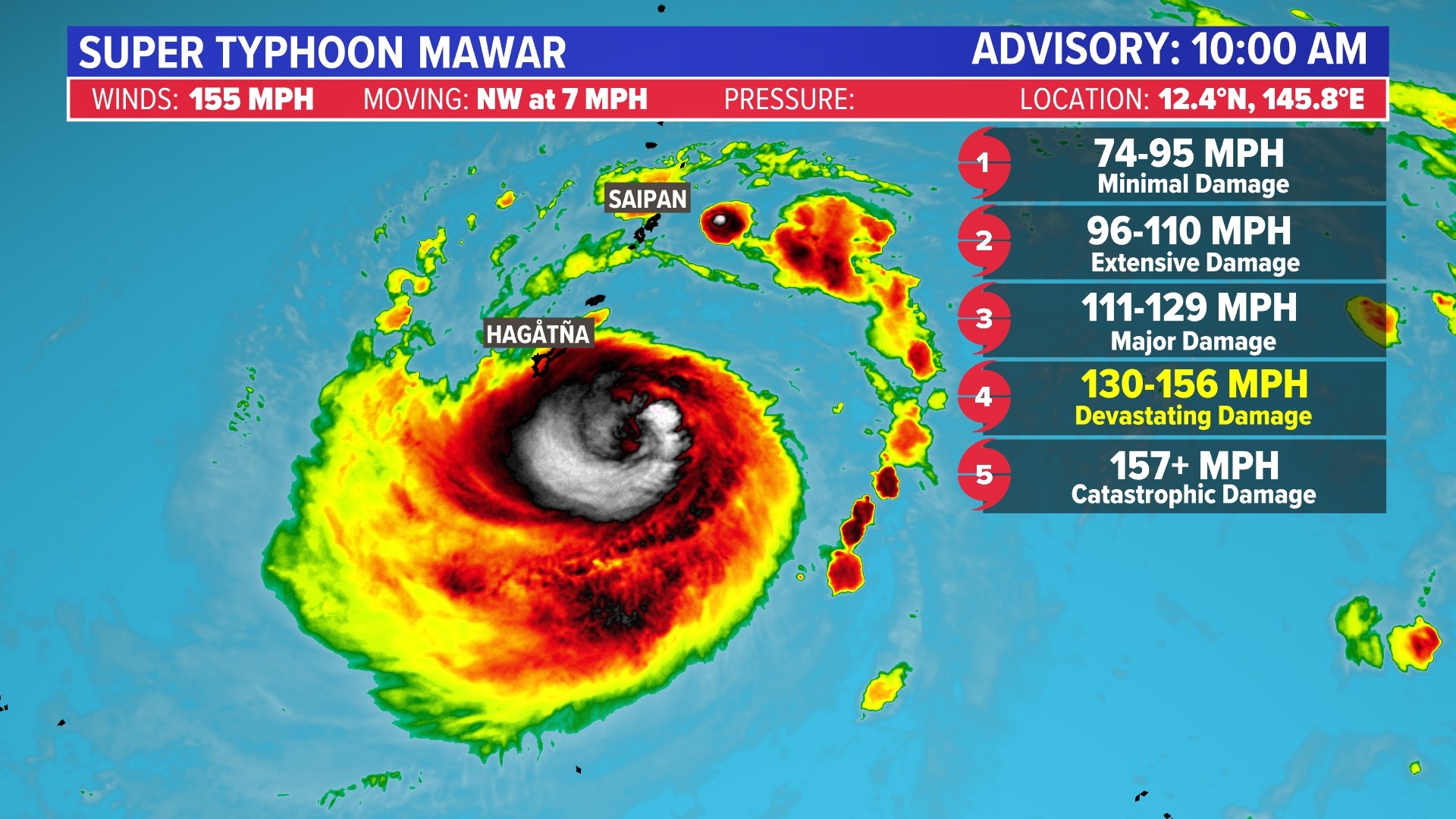HONOLULU — Powerful Typhoon Mawar churned slowly over the U.S. Pacific territory of Guam on Thursday, lashing the island with wind and rain, tearing down trees, walls and power lines, flipping cars, and pushing dangerous storm surge ashore as first-responders waited for daylight to see the full extent of the damage.
The typhoon, the strongest to hit the U.S. territory of roughly 150,000 people since 2002, briefly made landfall Wednesday night as a Category 4 storm at Andersen Air Force Base on the northern tip of the island, according to National Weather Service meteorologist Patrick Doll.
The slow-moving storm was battering the island with maximum sustained winds of 140 mph (225 kph), and it was expected to intensify through Friday, the weather service said.
Videos posted on social media showed fallen trees, a flipped pickup truck, solar panels flying through the air, parts of a wall of a multistory hotel crumbling to the ground and exposing rebar, and storm surge and waves crashing through coastal reefs. The early scope of the damage was difficult to ascertain, with power and internet failures making communication with the far-flung island difficult.


J. Asprer, a police officer in the Dededo precinct in northern Guam, said he hadn’t received any reports of injuries, but that several police cars and personal vehicles had been damaged by debris.
“Tin roofs flying around all over the place,” he said, noting that uprooted trees had made some roads impassable.
Most of the calls overnight had been from worried people off-island who were unable to reach family members, Asprer said.
“We told them we’ll have to wait until the storm clears up a bit," he said.
Ray Leon Guerrero, an assistant in the mayor's office in Barrigada, a village of about 9,000 people in central Guam, said he stayed at the office overnight fielding calls from nervous residents and heard objects slamming into the roof and outside walls constantly.
“Oh man. It was pretty noisy,” he said.
In a sign of how much help Guam might need, the U.S. Navy ordered the USS Nimitz aircraft carrier strike group to head to the island to assist in the recovery effort, according to a U.S. official. The Nimitz, along with the USS Bunker Hill, a cruiser, and the USS Wayne E. Meyer, a destroyer, were south of Japan headed to Guam, where they were expected to arrive in three or four days, said the official, who spoke on condition of anonymity to discuss ship movements not yet made public.
The weather service said the storm made landfall at around 9 p.m. Wednesday in Guam, which is about 3,800 miles (6,115 kilometers) west of Hawaii and 1,600 miles (1,575 kilometers) east of the Manila, the capital of the Philippines.
“It was on land for about 30 to 35 minutes before it moved back off shore,” Doll said by phone from the weather service’s office in Tiyan, Guam. “They lost their observation so we couldn’t see their wind speed.”
By early Thursday, Mawar was centered 45 miles (72 kilometers) northwest of Guam and 65 miles (105 kilometers) west-southwest of Rota, Guam’s neighbor to the north, moving west-northwest at 6 mph (10kph).
Mawar has moved slower than many others that have moved through the region at upwards of 10 to 15 mph (16 to 25 kph), weather service meteorologist Landon Aydlett said. Long-range forecasts place Mawar deep in the Philippine Sea, curving northward but staying northeast of the Philippines, he said, noting that it's possible it could regain super typhoon status, with maximum sustained winds of 150 mph (241 kph) or greater.
Peak winds at the weather service's Guam office reached 105 mph (169 kph), but the office later lost its wind sensors, Aydlett said. The building was vibrating with a “constant, low rumbling,” and its doors and windows were shaking, he said.
“We have the peak conditions going on for a couple more hours. I think thrashing is the word I would use,” he said by phone overnight. “There are trees everywhere at this point. Daylight tomorrow is really going to be a shock to a lot of people.”
In Tumon, on the island’s northeastern shore, winds tore a granite countertop from a hotel’s outdoor bar and tossed it 4 feet (about a meter) in the air. Guests scrambled to stack chairs against hotel doors being blown in from the gusts as windows buckled and creaked.
Tinian and Saipan, in the Northern Marianas, were under tropical storm warnings. Some people in those areas have been living in temporary shelters or tents since Category 5 Super Typhoon Yutu in 2018.
Mawar, a Malaysian word that means “rose,” might threaten Taiwan next week.
The weather service warned of an extremely dangerous and life-threatening situation in Guam and said people should take cover and remain in shelter for the next few hours.
“This is going to be kind of a long night. It's going to be scary because there’s no electricity unless you have a generator," Brandon Aydlett — a science and operations officer for the weather service, and Landon Aydlett's twin brother — said in a Facebook Live broadcast. “Reassure your children. It’s going to be a little bit scary as we go later into the night. You can hear the sounds: The winds are howling, things are breaking. Just be together, talk to each other and things will slow down toward midnight and continuing into Thursday morning.”
Many communities on the 212-square-mile (549-square-kilometer) island had lost power by Wednesday afternoon, and some to the south had lost water service. A flash flood warning was issued for the entire island as forecasters predicted as much as 25 inches (64 centimeters) of rain in addition to a life-threatening storm surge of 4 to 6 feet (1.2 to 2 meters).
Ahead of the storm, Guam Gov. Lou Leon Guerrero ordered those living in coastal, low-lying and flood-prone areas to evacuate to higher ground. The highest point on the island is Mount Lamlam in the southwest at 1,334 feet (406 meters). But much of the beachfront tourist district of Tamuning, where many resorts are located, is close to sea level.
School buses picked up residents at island community centers and took them to 11 elementary schools outfitted as shelters. Civic workers in villages warned residents to secure loose objects in their yards and seek shelter immediately. Some spread the word by megaphone, while others turned to social media. Power flickered off and on as the rain and wind intensified, and officials said nearly 900 people were in shelters.
Guerrero said an emergency declaration approved by President Joe Biden will support the mobilization of resources into Guam, which is “especially crucial given our distance from the continental U.S.”
Guam is a crucial hub for U.S. forces in the Pacific, and the Department of Defense controls about a third of the island. Rear Adm. Benjamin Nicholson, Joint Region Marianas commander, authorized the evacuation of defense personnel, dependents and employees from areas that were expected to be affected.
The military said it moved its ships out to sea as a standard precaution. It sent its aircraft off the island or placed them in protective hangars. Any personnel remaining on the island were sheltering in place. About 6,800 U.S. service members are assigned to Guam, according to the Pentagon.

